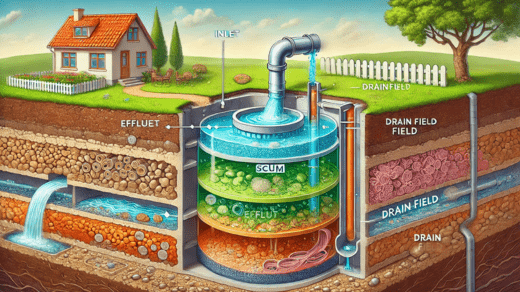If your home relies on a septic system for wastewater treatment, it’s important to understand how does a septic tank work? This underground structure plays a crucial role in treating and managing household wastewater, ensuring it’s safely filtered and reintroduced into the environment. In this article, we’ll take an in-depth look at how septic tanks function, how they break down waste, and what you can do to keep your system running efficiently.
What Is a Septic Tank?
A septic tank is part of an underground wastewater treatment system used in homes not connected to a municipal sewer line. It collects and treats wastewater from the household, separating solids from liquids, and facilitates the safe absorption of wastewater into the soil through the drain field. These tanks are typically made of concrete, fiberglass, or plastic and work alongside a drain field to naturally treat wastewater.
But how do septic tanks work on a daily basis? Let’s break it down step by step.
How Does a Septic Tank Work? – The Process
Septic tanks rely on a combination of gravity, natural filtration, and bacterial digestion to treat household wastewater. Here’s how the system operates from start to finish:
1. Wastewater Flows into the Tank
Every time you use water in your home—whether it’s from flushing the toilet, washing your hands, or running the washing machine—the wastewater flows into the septic tank via a main drainage pipe. This wastewater includes solid and liquid waste, soap, grease, and other household substances.
The tank serves as a holding area where the waste is processed and separated into different layers.
2. Separation of Solids, Liquids, and Oils
Inside the septic tank, the wastewater separates into three distinct layers:
- Scum Layer: The oils, fats, and grease float to the top, forming a scum layer.
- Effluent Layer: The middle layer contains relatively clear water known as effluent. This is the portion of the wastewater that gets discharged to the drain field.
- Sludge Layer: Heavier materials like solid waste and non-dissolvable particles sink to the bottom, creating the sludge layer.
The scum and sludge layers are retained in the tank, while the effluent layer is eventually released into the drain field for further filtration.
3. Bacterial Breakdown of Waste
The natural breakdown of waste in a septic tank is facilitated by anaerobic bacteria, which thrive in oxygen-free environments. These bacteria decompose the organic matter found in the scum and sludge layers. Over time, this bacterial digestion reduces the volume of solids, but not completely. Eventually, the tank will need to be pumped out to remove the remaining sludge and scum.
This biological process is one of the key factors in how do septic tanks work, as it reduces the amount of waste that accumulates in the system.
4. Effluent Discharge to the Drain Field
Once the effluent (the liquid middle layer) reaches a certain level, it flows out of the septic tank through an outlet pipe into the drain field. The drain field, or leach field, is a network of perforated pipes buried under the ground. These pipes distribute the effluent across a large area, allowing it to slowly seep into the soil.
The soil acts as a natural filter, trapping harmful bacteria, viruses, and nutrients as the effluent percolates downward. By the time the water reaches the groundwater, it has been purified and is safe for the environment.
5. Filtration and Absorption in the Soil
The final stage of the process happens in the soil beneath the drain field. The soil not only filters out any remaining contaminants, but also helps disperse the treated wastewater into the groundwater supply. A healthy, well-maintained drain field is essential for this process, as compacted or waterlogged soil can prevent proper filtration, leading to system failure.
Maintenance and Usage Tips
To ensure that your septic tank continues to function efficiently, it’s important to follow a few key maintenance tips and best practices. Septic tanks require regular care to avoid common issues like blockages, overflows, and drain field failure. Here’s how you can keep your system in optimal condition:
1. Pump Your Tank Regularly
The sludge and scum that accumulate in your septic tank must be removed periodically to prevent overflow and system failure. Most septic tanks need to be pumped every three to five years, depending on the size of the tank and the number of people in your household. A professional septic service can pump the tank and inspect it for any potential issues.
2. Mind What You Flush
Septic systems are designed to handle organic waste and water. Non-biodegradable items like wipes, diapers, paper towels, and feminine hygiene products should never be flushed, as they can clog the system and cause backups. Additionally, avoid pouring grease or oil down the drain, as these can build up in the scum layer and cause blockages.
3. Conserve Water
Excessive water usage can overload your septic system and lead to premature failure. To reduce the strain on your system, consider installing water-efficient fixtures, spacing out laundry loads, and fixing any leaky faucets or toilets. Using less water will give the tank more time to separate solids from liquids and reduce the chance of sending untreated wastewater into the drain field.
4. Protect Your Drain Field
Your drain field is a critical part of your septic system, and it needs to be protected from damage. Avoid planting trees or shrubs near the drain field, as their roots can grow into the pipes and cause blockages. Likewise, don’t park vehicles or place heavy objects on top of the drain field, as this can compact the soil and prevent proper filtration.
Common Problems with Septic Tanks
Even with proper maintenance, septic tanks can encounter problems over time. Here are some of the most common issues homeowners face, along with potential solutions:
1. Tank Overflow
If your septic tank is not pumped regularly, it can become full and overflow, causing untreated waste to back up into your home or yard. To prevent this, stick to a regular pumping schedule and watch for signs that your tank is nearing capacity, such as slow drains or foul odors.
2. Clogged Drain Field
A clogged drain field can lead to wastewater pooling on the surface of your yard, creating a health hazard. This usually occurs when the septic tank is not pumped frequently enough, allowing solids to flow into the drain field and clog the pipes. In some cases, the drain field may need to be replaced if the damage is severe.
3. Foul Odors
If you notice strong, unpleasant odors coming from your septic system, it could be a sign that something is wrong. Odors can indicate a variety of issues, from a full tank to a damaged drain field. Have a professional inspect your system to identify the source of the problem.
Conclusion
By understanding how does a septic tank work, you can take the necessary steps to ensure your system continues to operate efficiently. Septic tanks rely on natural processes to separate, treat, and dispose of household wastewater. By following best practices—such as regular pumping, conserving water, and protecting the drain field—you can extend the life of your septic system and avoid costly repairs.
If you experience problems with your septic tank or need professional maintenance, don’t hesitate to call a septic service expert. A well-maintained septic system is key to protecting your home, your property, and the environment.

